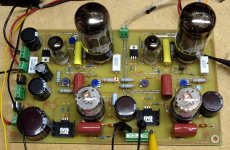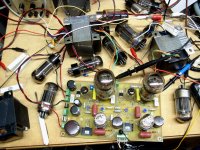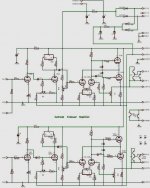Please check out this 6394A Triode Tube's | tube data If you'll go to page 4, in the second paragraph it states "A 30 second cathode time is recommended before the plate voltage is applied." What I'd like to know from those who are more knowledgeable than I am. Does that mean just when the 6394A tube is being used as a passing tube as described in that same paragraph or does that statement apply to the 6394A tube at all times and in all circumstances? The reason I'm asking is I think this would make a very interesting preamp tube. Might also make for an interesting SET tube as well...
TIA for any and all replies...
Thetubeguy1954 (Tom Scata)
TIA for any and all replies...
Thetubeguy1954 (Tom Scata)
You want to do that for any use at all. I don't know that particular tube, but generally when you see that on a datasheet, it means that the plate has some scavenging metals which need to be hot before current flows in order to prevent poisoning. This is especially common for tubes with graphite plates.
edit: Pulled up the datasheet and confirmed. This tube looks very similar to 6336. Not terrific for linearity, but would work well in a push-pull circuit.
edit: Pulled up the datasheet and confirmed. This tube looks very similar to 6336. Not terrific for linearity, but would work well in a push-pull circuit.
This might be a great build:
Un ampli chargecathodique de 30 W (G.Marec)
30 watts cathode output ...
Un ampli chargecathodique de 30 W (G.Marec)
30 watts cathode output ...
Hi,
That's one of those high altitude aviation regulator tube. Forget about it, it's too rare to be of any use.
Similar to its smaller brother the 6082.
Cheers,
Unless of course you happen to have a bunch of them..
Otherwise as Frank says they are relatively rare..
Hi,
That's one of those high altitude aviation regulator tube. Forget about it, it's too rare to be of any use.
Similar to its smaller brother the 6082.
Cheers,
Forget about it?
If I had "a couple dozens" of these like Hollowstate I would not mind use them for an amplifier.
I have heard excellent amplifiers with this kind of tubes (6AS7, 6336, 6C33C) especially when used cathode output.
Hi,
Any half decent amp (power and Zout-wise) amp will take up about four of those already.
With a OPT you could do with a pair per channel but then matching pairs are going to come from your small stash.
From experience I can tell you that matching anything like a 6080 and up in power is going to take more than just a few dozen of those bottles...
All in all not that great an idea not even to mention the mere ecological footprint of these babies....
Ciao,
Any half decent amp (power and Zout-wise) amp will take up about four of those already.
With a OPT you could do with a pair per channel but then matching pairs are going to come from your small stash.
From experience I can tell you that matching anything like a 6080 and up in power is going to take more than just a few dozen of those bottles...
All in all not that great an idea not even to mention the mere ecological footprint of these babies....
Ciao,
I had very similar problems with the 6C33, I had to purchase dozens to get just 6 well matched ones per channel. That OTL amplifier was ill-fated for a lot of other reasons including my need to design a needlessly complex amp which as designed was never going to work, and then I discovered low power SE.. 
You're quite right about finding tubes with matched or close sections. Back in the eighties, when I was actively dealing in vacuume tubes for gain, a fellow dealer had a large collection of 6394A's in his inventory. Since we were friends, he allowed me to sort through all that he had of this number. I tested all of them at JFF Research in Nutley New Jersey. This was a testing operation that served all the surplus dealers nation wide. John was an engineer and an ex-employee of ITT also in Nutley. (still is) From these I was able to gather several dozen that were pretty close section to section. Not perfect, but above average in match. I've been saving them for a big OTL someday. With a 1¼ amp filament, paralleling them is easier. They're the same wattage as 6336A's, but the lower amperage makes things easier.From experience I can tell you that matching anything like a 6080 and up in power is going to take more than just a few dozen of those bottles...
Eye candy below. Tubes on the ends have dust on the tops, not bad getters.
Attachments
Last edited:
If and when I do get enough time and physic gasoline, it will surely be a Circlotron style like the Atmasphere. That's the one that makes the most sense to me, and the easiest to implement. Pretty basic circuit of long tailed phase inverter>diff amp>diff cathode follower to grids with fixed bias.Hi,
Have you any idea what type of OTL circuit those babes are going to go in?
I have heard excellent amplifiers with this kind of tubes (6AS7, 6336, 6C33C) especially when used cathode output.
I made an SE amp using 6336A's or any of the tubes with the same pinout and it sounded great. It was a cathode follower design using the "Augmented Cathode Follower" design as outlined in Ross MacDonalds 1957 patent. It made over 10 WPC limited by the OPT's and the power supply.
I now have a power supply capable of exceeding the needs for this amp, so I'll have to hook it back up some day.
Attachments
This is an interesting schematic but I found out the 6336A on eBay are very expensive compare to the 6080/6AS7 or the much more linear russian 6S19P ... But is maximum 30W plate dissipation is a great avantage to get more output power than with average power triodes.This might be a great build:
Un ampli chargecathodique de 30 W (G.Marec)
30 watts cathode output ...
Alain.

Hi,
Being familiar with Marec's circuit I'm a little less enthousiastic.
This is one of he OTL schemes that appeared in L'Audiophile back in the seventies, right?. Hhmm, none of those were all that great.
Later on Buce Rozenblitt offered a design based around the less powerful 6AS7G which is a stable design close to what I drew up before he did.
That worked well with both 6AS7G and 6336As up to driving a sixpack of them.
In the end I still abandoned it as the 6336A's were not as stable as the 6080 (I much prefer those over the 6AS7G)
You know, tube like those aren't designed for this kind of use so you need to be aware of all the caveats....
IOW, currents drifting all over the place is what you may well get.... Grids being popped due to sudden current draw etc.
Ciao,
Being familiar with Marec's circuit I'm a little less enthousiastic.
This is one of he OTL schemes that appeared in L'Audiophile back in the seventies, right?. Hhmm, none of those were all that great.
Later on Buce Rozenblitt offered a design based around the less powerful 6AS7G which is a stable design close to what I drew up before he did.
That worked well with both 6AS7G and 6336As up to driving a sixpack of them.
In the end I still abandoned it as the 6336A's were not as stable as the 6080 (I much prefer those over the 6AS7G)
You know, tube like those aren't designed for this kind of use so you need to be aware of all the caveats....
IOW, currents drifting all over the place is what you may well get.... Grids being popped due to sudden current draw etc.
Ciao,
Last edited:
Being familiar with Marec's circuit I'm a little less enthousiastic.
This is one of he OTL schemes that appeared in L'Audiophile back in the seventies, right?
No Frank, you are wrong.
Maybe you could click the article and see that this amplifier sports an excellent quality c-core transformer....
Hi,
Yeah, you're correct. So I scrap the OTL part, mentally.
Damm, I should kow better. Thanks for correcting me. Maybe these bottles are better suited for x-former use after all?
Think about that,
No Frank, you are wrong.
Maybe you could click the article and see that this amplifier sports an excellent quality c-core transformer....
Yeah, you're correct. So I scrap the OTL part, mentally.
Damm, I should kow better. Thanks for correcting me. Maybe these bottles are better suited for x-former use after all?
Think about that,
Maybe these bottles are better suited for x-former use after all?
Especially with cathode output / output transformer coupling IMO very good amplifiers can be built using these class of tubes.
Checking the curves of the 6336A in the article, these look not bad at all, and using them as cathode followers will enhance linearity.
- Status
- This old topic is closed. If you want to reopen this topic, contact a moderator using the "Report Post" button.
- Home
- Amplifiers
- Tubes / Valves
- The 6934A Triode Tube
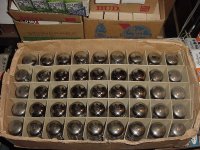
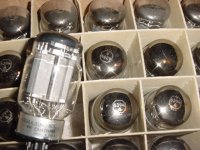
 . Nice stash you have there.
. Nice stash you have there.